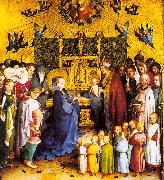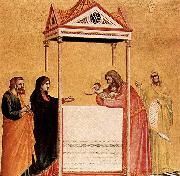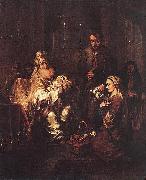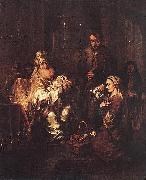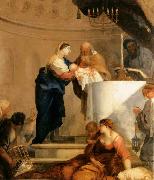Wholesale Oil Painting No Minimum |
|||||||||||
|
|
|||||||||||

|
|||||||||||
|
|
|
||||||||
Lochner, StephanGerman Northern Renaissance Painter, ca.1400-1451 |
||||||||
|
|
||||||||
Presentation in the Temple
Presentation in the Temple Painting ID:: 19199 |
1447, Mixed technique on wood, Hessisches Landesmuseum, Darmstadt. 1447, Mixed technique on wood, Hessisches Landesmuseum, Darmstadt. |
|||||||
|
|
||||||||
GIOTTO di BondoneItalian Early Renaissance Painter, 1267-1337 Italian painter and designer. In his own time and place he had an unrivalled reputation as the best painter and as an innovator, superior to all his predecessors, and he became the first post-Classical artist whose fame extended beyond his lifetime and native city. This was partly the consequence of the rich literary culture of two of the cities where he worked, Padua and Florence. Writing on art in Florence was pioneered by gifted authors and, although not quite art criticism, it involved the comparison of local artists in terms of quality. The most famous single appreciation is found in Dante's verses (Purgatory x) of 1315 or earlier. Exemplifying the transience of fame, first with poets and manuscript illuminators, Dante then remarked that the fame of Cimabue, who had supposed himself to be the leader in painting, had now been displaced by Giotto. Ironically, this text was one factor that forestalled the similar eclipse of Giotto's fame, which was clearly implied by the poet. |
||||||||
|
|
||||||||
|
|
Presentation in the Temple
Presentation in the Temple Painting ID:: 44325 |
1320-25
Tempera on wood,
44 x 43 1320-25 Tempera on wood, 44 x 43 |
||||||
|
|
||||||||
Gerbrand van den Eeckhout1621-1674 Dutch Gerbrand van den Eeckhout Location Dutch painter, draughtsman and etcher. He was the son of the goldsmith Jan Pietersz. van den Eeckhout and a great friend as well as a pupil of Rembrandt, according to Houbraken, who commented that van den Eeckhout painted in the style of his master throughout his career. This is certainly true of van den Eeckhout (biblical) history paintings, but less so of either his portraits, which gradually displayed more Flemish elegance, or his genre pieces (from 1650), in which he followed various trends; he adapted his style to suit his subject with sensitive versatility. He was also a gifted colourist and an artist of great imagination, superior in both these respects to such better-known Rembrandt pupils as Ferdinand Bol and Nicolaes Maes. Moreover, he was extremely productive, and there is at least one dated painting for virtually every year between 1641 and 1674. In addition, he created a large body of drawings comprising histories, figures, landscapes and genre scenes executed in various media, including watercolour. He also made several etchings, mostly studies of heads, such as the Self-portrait (1646; B. 66). He died a bachelor, aged 53. |
||||||||
|
|
||||||||
|
|
Presentation in the Temple
Presentation in the Temple Painting ID:: 84517 |
Date 1671(1671)
Medium Oil on wood
Dimensions Height: 59 cm (23.2 in). Width: 48.5 cm (19.1 in).
cjr Date 1671(1671) Medium Oil on wood Dimensions Height: 59 cm (23.2 in). Width: 48.5 cm (19.1 in). cjr |
||||||
|
|
||||||||
Gerbrand van den Eeckhout1621-1674 Dutch Gerbrand van den Eeckhout Location Dutch painter, draughtsman and etcher. He was the son of the goldsmith Jan Pietersz. van den Eeckhout and a great friend as well as a pupil of Rembrandt, according to Houbraken, who commented that van den Eeckhout painted in the style of his master throughout his career. This is certainly true of van den Eeckhout (biblical) history paintings, but less so of either his portraits, which gradually displayed more Flemish elegance, or his genre pieces (from 1650), in which he followed various trends; he adapted his style to suit his subject with sensitive versatility. He was also a gifted colourist and an artist of great imagination, superior in both these respects to such better-known Rembrandt pupils as Ferdinand Bol and Nicolaes Maes. Moreover, he was extremely productive, and there is at least one dated painting for virtually every year between 1641 and 1674. In addition, he created a large body of drawings comprising histories, figures, landscapes and genre scenes executed in various media, including watercolour. He also made several etchings, mostly studies of heads, such as the Self-portrait (1646; B. 66). He died a bachelor, aged 53. |
||||||||
|
|
||||||||
|
|
Presentation in the Temple
Presentation in the Temple Painting ID:: 88368 |
1671(1671)
Medium Oil on wood
cyf 1671(1671) Medium Oil on wood cyf |
||||||
|
|
||||||||
Sebastien Bourdon(2 February 1616 - 8 May 1671) was a French painter and engraver. His chef d'œuvre is The Crucifixion of St. Peter made for the church of Notre Dame. The Finding of Moses, c. 1650 (National Gallery of Art, Washington)Bourdon was born in Montpellier, France, the son of a Protestant painter on glass. He was apprenticed to a painter in Paris. In spite of his poverty he managed to get to Rome in 1636; there he studied the paintings of Nicolas Poussin, Claude Lorrain and Caravaggio among his eclectic selection of models, until he was forced to flee in 1638, to escape denunciation by the Inquisition for his Protestant faith. Bourdon's facility rendered him adept at portraiture, whether in a dashing Rubens manner or in intimate, sympathetic bust-length or half-length portraits isolated against plain backgrounds that set a formula for middle-class portraiture for the rest of the century, landscapes in the manner of Gaspar Dughet or cappricci of ruins, mythological "history painting" like other members of Poussin's circle or the genre subjects of the Dutch Bamboccianti who were working in Rome. His eclectic range of styles have given art historians exercise in tracing his adaptation of his models, while the lack of an immediately recognizable "Bourdon style" has somewhat dampened public appreciation. In 1652 Christina of Sweden made him her first court painter. Bourdon spent most of his working career outside France, where, though he was a founding member of the Academie de peinture et de sculpture (1648), he was for long largely dismissed as a pasticheur, a situation partly rebalanced by a comprehensive exhibition in 2000 of his work at the Musee Fabre, where the collection includes a fine Lamentation painted in the last years of his life. His success required the establishment of an extensive atelier, where, among his other pupils worked Nicolas-Pierre Loir and Pierre Mosnier. He died in Paris in 1671. |
||||||||
|
|
||||||||
|
|
Presentation in the Temple
Presentation in the Temple Painting ID:: 96038 |
circa 1644(1644)
Medium oil on canvas
cyf circa 1644(1644) Medium oil on canvas cyf |
||||||
|
|
||||||||
|
Sebastien Bourdon (2 February 1616 - 8 May 1671) was a French painter and engraver. His chef d'œuvre is The Crucifixion of St. Peter made for the church of Notre Dame. The Finding of Moses, c. 1650 (National Gallery of Art, Washington)Bourdon was born in Montpellier, France, the son of a Protestant painter on glass. He was apprenticed to a painter in Paris. In spite of his poverty he managed to get to Rome in 1636; there he studied the paintings of Nicolas Poussin, Claude Lorrain and Caravaggio among his eclectic selection of models, until he was forced to flee in 1638, to escape denunciation by the Inquisition for his Protestant faith. Bourdon's facility rendered him adept at portraiture, whether in a dashing Rubens manner or in intimate, sympathetic bust-length or half-length portraits isolated against plain backgrounds that set a formula for middle-class portraiture for the rest of the century, landscapes in the manner of Gaspar Dughet or cappricci of ruins, mythological "history painting" like other members of Poussin's circle or the genre subjects of the Dutch Bamboccianti who were working in Rome. His eclectic range of styles have given art historians exercise in tracing his adaptation of his models, while the lack of an immediately recognizable "Bourdon style" has somewhat dampened public appreciation. In 1652 Christina of Sweden made him her first court painter. Bourdon spent most of his working career outside France, where, though he was a founding member of the Academie de peinture et de sculpture (1648), he was for long largely dismissed as a pasticheur, a situation partly rebalanced by a comprehensive exhibition in 2000 of his work at the Musee Fabre, where the collection includes a fine Lamentation painted in the last years of his life. His success required the establishment of an extensive atelier, where, among his other pupils worked Nicolas-Pierre Loir and Pierre Mosnier. He died in Paris in 1671. Presentation in the Temple circa 1644(1644) Medium oil on canvas cyf |
||||||||
|
|
||||||||
|
Prev Next
|
||||||||
|
|
||||||||
|
Related Paintings to Sebastien Bourdon :. |
||||||||
|
|
||||||||
|
CONTACT US |
